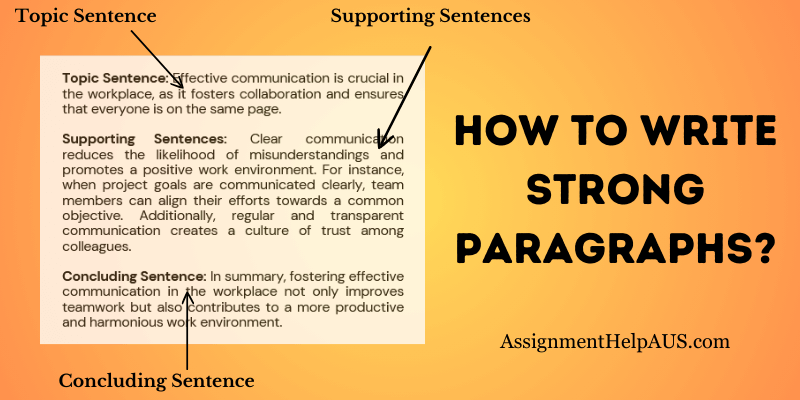Paragraph Structure, as well as headings, structure all types of academic writing. The length, number and order of the sections depend on the topic on which you are writing, but each of the Para’s must be:
Unified: all the related sentences need to converge to one central point
Coherency: all the sentences need to be organized logically and very much connected
Relevance: the Para’s need to support the overall purpose and theme of your paper
What is a Paragraph?
A paragraph is a piece of writing that develops the main idea via a series of related sentences. The main idea is introduced in the first sentence of the paragraph structure, the topic sentence. This idea is then developed further through the following sentences.
How Many Parts of a Paragraph?
Most of the paragraphs in an essay have 3 part paragraphs structure: introduction, body, and conclusion. These paragraph structures can describe, describe, narrate, contrast, compare, or analyse information. Each paragraph of your essay plays a very important role in communicating with your readers:
- Introduction: This part of your paragraph includes the topic and other sentences at the beginning that give the reader background information.
- The body follows the introductory part and discusses the main idea using facts, arguments, examples, analysis, etc.
- Conclusion: This is the final part of your essay that connects the discussed information in the paragraph body and the controlling area.
Also Read : How to Write a Master’s Dissertation?
5 Useful Steps to Writing an Authentic Paragraph
1. Decide the paragraph’s main topic: Before starting to write your paragraph, you must have a crystal-clear idea about the topic. Your paragraph always needs to be a coherent collection of sentences relating to one centralized topic. Thus, it would help if you always had a definite idea about it.
2. Writing down the ideas and information related to the topic: After developing an obvious idea of what you want to convey to your readers through your paragraphs, you can organise your thoughts by jotting down your ideas on a Word document or notepad. You may not write in full sentences. You can jot down some keywords with phrases. After you see these on paper, you can get an even more precise idea of the essential points in your life and eliminate the unnecessary ones. Here, you can also realize that a gap in your knowledge is necessary to look up some facts and figures to support your argument. Doing the research early is always a better idea so that you can collect all the relevant information easily and quickly at your writing stage.
3. Figuring out your paragraph structuring way: After clearly stating all of your thoughts, facts, ideas, and figures, you can start thinking about adequately structuring your paragraph. Here, you need to consider each of the points that you want to address and arrange them in a very logical manner. This will make your paragraph more coherent in reading and easier to understand by your audiences. This paragraph’s structuring order can be chronological or may put the major information first to make the paragraph structure more interesting to read. This will also largely depend on your subject topic.
4. When to move to the following paragraph: Sometimes, it becomes difficult to determine which Para will end and which will begin. Here, you can follow specific guidelines; the basic guideline is that you must move to the next paragraph whenever you discuss any new idea. Your pars should contain at most one basic idea. If your central idea has multiple facets, then individual aspects should be given in the paragraph. New Para can also be given while you are contesting 2 points or presenting one side of the army argument. The paras need to make any writing easier to comprehend and give your readers a break between 2 new ideas discussed in your writing piece. You can also split your paragraph into 2 pieces if it needs to be shorter and complete for the readers.
5. Check the style and coherency: Your paragraphs should have enough style and coherency to draw your readers’ attention. You can do this by varying the format and length of your sentences and using transitional words with varied vocabulary.
Also, Check Out: What are the Significance of Utilizing Examples in Assignments?
Common Types of Paragraphs That Students Use Normally
There are 4 different types of Paragraph Structure – descriptive, expository, narrative, persuasive and expository. These four types allow students to write on any subject topic.
1. Descriptive paragraph: This type of paragraph structure describes anything and shows your audience what you are writing about. The words chosen here mostly appeal to the five senses: touch, smell, hearing, vision, and taste. These types of paragraphs can be artistic and might deviate from grammatical norms.
2. Narrative paragraph: Narrative paragraphs usually tell a story. They have a clear beginning, middle, and end.
3. Expository paragraphs: These types of paragraphs explain something or give information on a particular subject area. They can also describe any process and walk the readers systematically through it. It would help if you did research before writing these types of paragraphs. However, you also need to rely on your own experience and knowledge.
4. Persuasive paragraph: This type of paragraph gets the audience to accept a particular point of view or understand the writer’s position. These types of sections are beneficial in building up any argument. It would help if you always researched many facts and figures.
Also Read: What are the Academic Assignment Writing Guidelines?
How Do You Create Correct MLA Style Citations in Essays?
Citing sources is necessary for a research paper. This shows that you have written the necessary things to make credible arguments. It will help your readers understand the context of your quote. You must cite or paraphrase all direct quotes from other sources to avoid plagiarism. If you cite your sources properly, you will be an experienced writer.
In order to create your reference citation, you need the following information:
- Research topic title
- Editor name
- Proper version
- Publication information
- Needed in-text citations
MLA Formatting
An abstract is a short summary of a finished research paper that motivates readers to keep reading. It is a reduced form of a long writing piece that focuses on the key points and briefly describes the scope and context of the paper.
An MLA format, primarily abstract, aims to summarize the research paper’s methods, findings, conclusions, and discussions. Abstracts are generally 100-250 words and consist of 5-7 sentences.
It can also include precise descriptions of your objective, motivations, methods, findings, conclusions, etc. of the research paper. Here, the purpose of your paper writing and why the audience needs to read it can also be included.
Abstracts allow for a quick summary of your paper for other researchers. Busy researchers don’t have time to read everything, so they rely on the abstract to help them decide whether or not they will read the paper.
Also, Go Through the Interesting blog on How to Write an Essay in MLA Format.
Needing an Abstract:
An abstract in MLA style is very commonly used in humanities subjects. For example, you can use MLA style when writing a research paper on religion, literature, or philosophy.
Types of Abstracts:
The descriptive abstract is generally 100 words long and gives an overall summary of the paper. It does not usually include any results or conclusions.
The informative abstracts are 150-250 words long and summarize the whole research paper.
Writing the abstract: write it after finishing the main paper
Review your paper and make an outline of the major points
Write about the research method in detail
Focus on your findings and results
Write your finding’s implications, too
Condense larger points to narrow them
Always follow a proper outline
Refer to a rough draft made by you
Formatting:
- Using 1-inch margins
- Writing the body after the title
- Making double spaces
- Using one space after the punctuation mark
- Start writing the first outline of the Para with an inch gap from the left side margin
- I prefer using point fonts like Times New Roman or Arial.
- Spell out acronyms.
- Write in italics rather than using question marks while referencing any work.
Conclusion:
This blog clearly states that writing a splendid paragraph on any topic takes work. Thus, you always need expert help in this regard.
When writing a paragraph structure in the assignment? Are you available for the best guidance and tips to upgrade your writing skills?
- Assignmenthelpaus.com is always the number one chance for you to write a good paragraph and avail of the service.
- We will always provide you with the best tips and guidance in this regard.
- We provide round-the-clock services
- Top writers work with us
- Our team always provides plagiarism-free services
Thus, join us soon.
Latest & Interesting Blogs that Would Be Helpful for You
⇒ How to Write An Essay in MLA Format?
⇒ 8 Useful Tips to Write an MBA Assignment Efficiently
⇒ How to write a Dissertation Proposal? Guide & Example
⇒ How to Stay Focused on Studies? Some Essential Tips
 I’m Harry Thompson from Australia. As per my work experience and knowledge, I have written for Assignmenthelpaus.com for many years on specific topics like dissertations, essays, guidance, plagiarism, formatting, etc. I hope you guys will like this post, which will prove useful.
I’m Harry Thompson from Australia. As per my work experience and knowledge, I have written for Assignmenthelpaus.com for many years on specific topics like dissertations, essays, guidance, plagiarism, formatting, etc. I hope you guys will like this post, which will prove useful.





